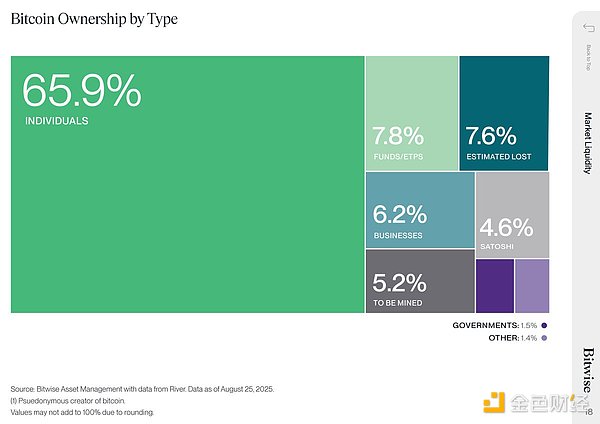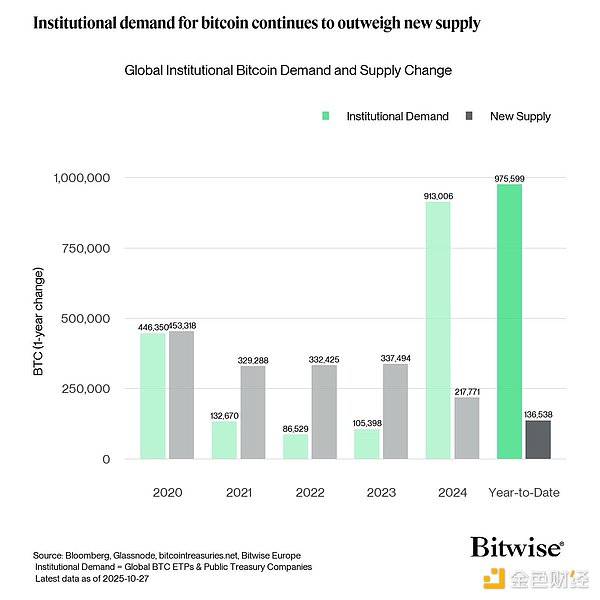Author: André Dragosch, Head of Research, Europe, Bitwise; Translation: Jinse Finance xiaozou
"When in doubt, look at the longer timeframe"
This is the essence of the key chart in our latest Bitwise Quarterly Market Report.

This data clearly reveals the current general trend and even explains the peculiarities of this Bitcoin cycle (data provided by River). 1. Deciphering the Essence of the "Great Wealth Transfer" The key point is that Bitcoin is flowing from early retail investors to institutional investors (funds/exchange-traded products), corporations, and even government entities. Unlike other traditional asset classes, Bitcoin's adoption began with retail investors like cypherpunks and early adopters, followed by the initial investment of institutional investors like family offices, fund managers, and ETFs. Even today, retail investors still account for approximately 66%, meaning that the vast majority of Bitcoin is still controlled by non-institutional investors (see the matrix distribution in the figure above)! In comparison, the latest data from US 13F filings shows that institutional investors hold significantly higher allocations in traditional asset classes. Looking at the institutional holdings of mainstream traditional financial ETFs: 79% of institutional holdings are held in the iShares 20+ Year Treasury Bond ETF (TLT); 58% in the SPDR S&P 500 ETF (SPY); and 36% in the SPDR Gold ETF (GLD). By comparison, the latest Bank of America Global Fund Manager Survey shows that the average allocation to crypto assets (including Bitcoin and other tokens) is currently only 0.4%. (Additional note: Institutional holdings in IBIT currently only account for 26%…) This demonstrates that, as the industry often says, "we're still in the early stages," institutional adoption is still in its infancy. However, it's undeniable that a massive transfer of wealth from retail investors to institutions is occurring. This shift in wealth from early adopters to institutional investors will have multiple impacts, potentially far-reaching beyond imagination: 2. Bitcoin Popularization: Trends and Cycles (1) Trends First, let's be clear: this transfer won't happen overnight; it's a long-term trend. The reality is that the majority of Bitcoin is illiquid and held for the long term. Only approximately 14.5% of the Bitcoin supply is held on exchanges like Coinbase and Binance, offering relative liquidity. The rest remains illiquid in off-chain wallets. Without economic incentives, Bitcoin wealth won't automatically transfer. Many early holders set psychological price points (such as $1 million per BTC) or economic goals (such as "house funding") as triggers for selling Bitcoin, which is significantly higher than the current market price of approximately $115,000. To attract these illiquid tokens to the market (i.e., exchanges), Bitcoin prices would need to rise significantly. This process will expand Bitcoin adoption as ETFs hold assets in trust for millions of individual investors. Public company financial reports also show that Bitcoin is held by hundreds of thousands of different investors. As of this writing, institutional investors (ETPs and public companies) control approximately 12.5% of the Bitcoin supply—and the number is rising rapidly. Most analysts likely agree that early Bitcoin bull and bear cycles were primarily driven by the halving event, which occurs every 210,000 blocks (approximately four years). This mechanism cuts Bitcoin output in half (hence the term "halving"). However, the impact of halvings has diminished with each event—both in absolute terms and relative to circulating supply. With increasing institutional adoption and shifting demand structures, the halving effect has significantly weakened.
Data from 2025 shows that institutional demand has reached approximately seven times the supply gap caused by the halving!

During this process, the influence of traditional macro cycles has increased relatively—Bitcoin has become a true "macro asset."
Our quantitative analysis also shows that over 80% of Bitcoin's price fluctuations over the past six months were driven by macro factors such as global growth expectations and monetary policy, while token-specific factors contributed less than 5%. However, the dominance of macroeconomic factors also means that Bitcoin's future bull and bear cycles will fluctuate in tandem with the macro/business cycle, and the four-year cycle driven by the halving is likely to become ineffective. This ultimately suggests that Bitcoin's accumulation and distribution will depend on the prevailing macroeconomic environment (expansion/boom vs. contraction/recession), thereby triggering short-term price fluctuations based on risk-on/risk-off patterns. 3. Conclusion The fundamental meaning of the "great transfer of wealth" is that Bitcoin prices need to reach higher levels—much higher than their current levels—to incentivize further adoption and complete the transfer of funds from early retail investors to institutional investors. The continued influx of institutional investors means that Bitcoin has become a true "macro asset," indicating that future bull and bear cycles will be increasingly driven by macro/business cycles (rather than halving events).
 Anais
Anais






